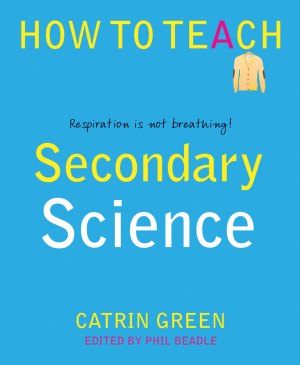How to teach Secondary Science by Catrin Green
reviewed by Aleksandra Zaparucha, Poland

Independent Thinking Press.
ISBN 978-178135241-0,
pp. 214
One of the most difficult tasks for CLIL teacher trainers, especially those working with secondary subjects teachers, is to convince the course participants that they should take responsibility for the language and not only for the content they teach.
The book How to teach Secondary Science by Catrin Green (ed. Phil Beadle, Independent Thinking Press) will thus come handy to all those involved in CLIL – both Science teachers themselves and CLIL teacher trainers. This is because although the book does not consider English language learners (ELL), it is full of… language ideas and suggestions. And don’t be misled by the title, the book’s content can be extended to other subjects than Science and to various ELL situations.
The very first page of the book advocates for using… storytelling in Science lessons, necessarily with a catchy title – often in the form of a question – so as to draw the students’ attention to the content and to make sure they see ‘a big picture’. This ‘mental hook’ or ‘mental anchor’ is at the core of remembering stuff. So, Why do people hate chemicals? offers a much better start than just Chemicals; What are we really made of? is better than just Atoms; and Why do 100,000 people die of cholera every year but I’ve never heard of it? promises a more exciting lesson of Biology than Epidemics.
Clear explanation with carefully used subject-specific language as well as constant checking understanding – these are further issues a Science teacher needs to master. This part of the book offers some real-life examples of lesson material as well as techniques for making sure we can move on with it.
But how to make Science content really memorable? How to teach so as it sticks for good? The author’s suggestions include stuff a language teacher will recognise easily: debates, role plays, games and props. Songs will help memorise all these difficult vocabulary items, like alkanes and alkenes or mitosis and meiosis (you will find loads of those on the Internet!). Even drama and dancing have found their way into the Science classroom! You can ask your students to act out the three states of matter (drama) and help them learn how a fossil fuel power station works by asking them to dance! Making it memorable also requires frequent recalls, and besides the rationale for it, the book offers a range of activities helping making recycling the content more enjoyable for both the teacher and the students.
The goal of Science teaching is to enable secondary students to ‘talk science’ but it is a new language for them, be it they study it in their native language or in another language. Thus they need to master a range of vocabulary items specific solely to a given subject as well as have loads of opportunities to express their ideas. And this language of Science needs to be taught explicitly! Here comes handy a wide selection of vocabulary games as well as links to online resources the book contains.
The next big issue the book discuses is the need for a joined-up curriculum, supported by suggestions how to teach evolution, particles and energy. This is followed by an extensive chapter dealing with difficult topics (electricity, heat, moles, osmosis and reproduction). The author also offers her insight into combining Science curriculum with necessary Math skills, into organising practical activities and into various forms of assessment.
So, if you are intrigued what Vocabulary Ninja is, what Whiteboard challenge is all about and whether Schrodinger’s cat is dead or alive – grab the book ‘How to teach Secondary Science’ and indulge yourself in the author’s witty suggestions. If only my high school science teacher had read it when I was still at school!

Please check the CLIL for Secondary course at Pilgrims website.


|